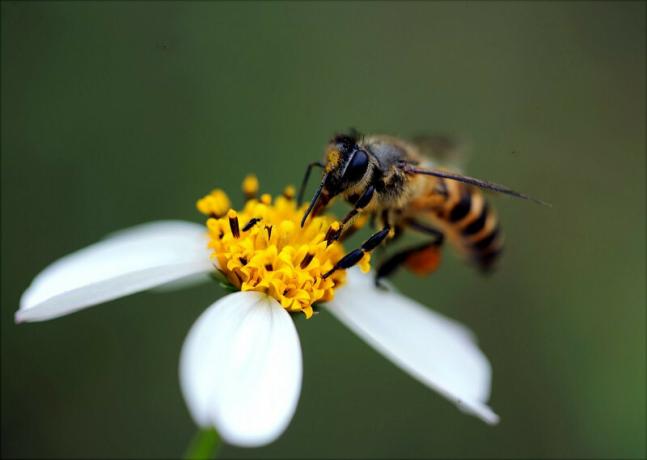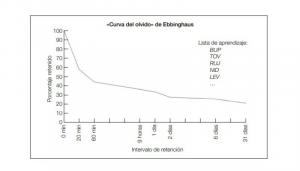Do insects have cognition?
Many animal species have been shown to have cognition and other characteristics that were traditionally considered unique to the human species.
Other mammals, birds, reptiles and mollusks such as the octopus are capable of solving relatively complicated tasks, but it seems that few are considering the possibility that smaller animals are capable of same.
Do insects have cognition? This is a question that, although it may seem hilarious to more than one, science has taken seriously in recent years. Let's see what they found ...
- Related article: "Cognitive psychology: definition, theories and main authors"
Do insects have cognition? Experiments to understand your mind
The human being has found similarities in other species with regard to their intelligence, emotions, personality and behavior. We have known for a long time that dolphins, birds, dogs, cats, reptiles and, like no, other primates like us have a higher level of understanding than decades ago believed. Humans have long since stepped off the pedestal and abandoned the idea that we are the only ones with cognition.
However, certain prejudices still exist regarding what they can feel, understand and perceive animals that, because of their miniscule size and relative simplicity, we would not believe that they have something close to cognition: insects Do insects have cognition? Your brain is tiny, with neural networks that make you laugh compared to those of an animal like a dog.So it's even comical to pose this question seriously.
But science does not care what prejudices the average citizen has with respect to flies, bees and mosquitoes. There are many investigations that have come to show that these arthropods, with or without wings, are capable of learning and teaching, having emotions, goals and expectations. Throughout this article we are going to talk about a few experiments in which various aspects related to the idea of cognition in insects have been tested.
- You may be interested in: "Comparative Psychology: the animal part of psychology"
Ants with expectations
In the late 1970s, Daniel Kahneman and Amos Tversky expounded the prospect theory. This suggests that human beings do not perceive the value of things in absolute terms, but in a relative way and taking something as a reference.
For example, if we go to a bar and they give us brick orange juice every time we go there, the day they serve us real orange juice freshly squeezed, it will taste like glory, valuing it much more than another customer who had been served juice from the first day he went to that bar squeezed. We will be surprised as our expectations, which were low, have been exceeded.
It is seen that the same occurs also in ants. In their experiment, Stephanie Wendt and colleagues (2019), trained ants with sugar drops of different concentrations. They saw that the value that ants give to a food depends on the expectations they have, which were formed during training. Thus, if the ants expected to receive a drop with a low concentration of sugar and received that same drop throughout the experiment, his behavior was inconspicuous, moving a little from side to side and occasionally sucking on the drop.
Nevertheless, the behavior of the ants that in the experiment were presented with a drop with a higher concentration of sugar was totally different. Unlike the previous ants, these, which also went towards the gout with expectations rather low, when discovering the delicious delicacy that was before them they focused fully on the sweet nectar. Concentrated, they did not move a single millimeter and they sucked tirelessly giving themselves a real feast at having discovered such a succulent treasure.
- Related article: "Are insects in pain?"
Caffeinated bees and flowers
Coffee is that heavenly nectar that many people need to drink as soon as they wake up. This substance helps to awaken our mind and it seems that it also does it in bees, helping them to remember things better. The study by Sarah Arnold and colleagues (2021) tested to see what happened when bees were given caffeine in the sweet nectar they took through flowers and if this influenced their memory.
Scientists already knew that caffeine, which is found naturally in citrus trees and the coffee plant itself, plays a very important role in making bees frequent consumers of its caffeinated flowers. Experiments prior to his had already found that bees preferred flowers that had caffeinated nectar but it was not known if this was simply a preference or if it influenced the memory of flowers that contained a sweet prize.
To answer this question, Arnold's team decided to give the bees caffeine when they were around of their nest, causing them to associate the taste of sweet nectar with that of the artificial aroma of the Strawberry. They took 86 bees that divided them into three groups: one in which the bees were starters with the smell of strawberry and a sugar solution with caffeine; a second in which the bees were trained to associate the smell of strawberry with the sweet reward, but without the caffeine kick in between; and a third control group that was simply given the sugar solution without odor or caffeine.

After training, the experimenters were releasing the bees in a kind of flight stage where they had to choose between two types of artificial flowers: some with strawberry essence and others with other essences that acted as distracting flowers. The hypothesis was that those bees that had not associated the smell of strawberry and nectar, would visit the two types of robotic flowers equally.
The researchers saw that caffeine greatly influenced the memory of these Hymenopterans. 70.4% of the bees that had been trained with the caffeine kick first visited the flowers that smelled like strawberry, unlike bees trained without such a kick but with aroma, which took strawberry-scented flowers 60% of the time as their first option. The bees in the control group, which had only been fed nectar without aromas or caffeine in the process, only 44.8% of them chose to go first to the strawberry-scented flowers.
This experiment suggests that bees learn best by drinking caffeine, consciously choosing those flowers that they know bring with them reward just as they had been taught in the training.
- You may be interested in: "Fear of insects (entomophobia): causes, symptoms and treatment"
Bumblebees that learn and teach
We went from bees to bumblebees, which some call "flying teddy bears." Well, there are not many who call them that, but the researchers of the following case in which it has been found out if these insects have the ability to learn and teach their fellow human beings.
Bumblebees are animals that seem to have an amazing ability to come up with new solutions. And not only this, but if they see that there is a partner nearby, they look at him and help him. They do not limit themselves to copying what they see or trying by pure trial and error, but they are able to adapt what they have observed to be able to solve a situation more efficiently, thus showing certain behavior creative.
Research from the Queen Mary University of London proves this. Its authors, Olli Loukola and colleagues (2017), they trained bumblebees to move small balls to the center of a platform to get sugar water. The behaviors observed throughout the experiment, according to Loukola, demonstrate an astonishing cognitive flexibility, as well as a conscious interest in replicating the behavior seen in their like-minded people.
The experiment was carried out with three groups of bumblebees of ten specimens each. The insects of the first group faced the problem for the first time but having a bumblebee previously trained tutor who showed them what to do to get water sugary. The second group consisted of teaching the bumblebees what to do through a "ghost" demonstration, in which the researchers moved the ball from the outside with a magnet. In the third group, the ball was already in the circle when the insects were introduced into the experimental setting.
What the researchers observed was that insects that learned through a congener had extremely high success rates, succeeding 99% of the time. Bumblebees that were trained with the ghost ball were 78% successful, while those with the ball already in place figured out what to do 34% of the time. This experiment goes to show that bumblebees are capable of developing new behaviors and teaching them consciously.
- Related article: "The 9 most important learning theories"
Bad smells, good smells and flies
Finally we leave the case of other winged insects, in this case fruit flies. A group of Bristol researchers in 2018 trained flies using two scents associated with two different stimuli. In their experiment, they had the flies learn to associate a positive smell (P) with a sugar-based treat, and a negative smell (N) with an unpleasant vibration. During training they were exposed to one of these smells and also to a jet of clean air, and it was up to them to choose between one or the other.
Once the flies had been trained they were separated into two groups. Flies in group A were shaken for one minute and those in group B had nothing done. After that, they exposed these two groups to the N and P odors, but this time they included a new one, a mixture of both odors that we will call P + N. The flies did not know if the P + N smell brought sugar or vibration with it, since it was the mixture of the two smells from training, so they would have to take a chance if they chose it.
The results were revealing. The flies that had been agitated in training did not want to take risks and showed some fear of being agitated againIn addition, it seemed that they valued less the sweet prize of sugar associated with the smell of P. Their demeanor was cautious, fearful, pessimistic, and they implied that they remembered very well that the N odor carried with it an unpleasant sensation.
This experiment indicates that flies, despite their tiny brain, are capable of learning and, also, can present something similar to learned helplessness. Being in a situation of doubt, where two stimuli are presented and that have been associated with consequences of different signs, makes the flies not know what to do. If they didn't have the slightest bit of cognition and only behaved instinctively, they would most likely just take a risk.
- You may be interested in: "Olfactory system: reception, transduction and brain pathways"
Final reflection
These experiments, along with many others, have shown that insects, despite having tiny brains and extremely simple neural circuits, they are capable of solving excessively difficult tasks. They recognize visual patterns, memorize the scent of flowers, learn to move levers, balls or even to pull strings.
The cases we have talked about correspond to social insects, which could be assumed that few species of these arthropods are capable of presenting something similar to cognition. It makes sense that these particular species can learn and teach behaviors to other individuals because the behavior of each of them is decisive for the health of the colony, as is the case with bees, ants and other hymenopterans.
However, considering that individualistic insects have brains not much simpler than the Of social insects, it would not be strange at all to find these same behaviors in these species. Whether social or individualistic, everything seems to indicate that yes, insects have cognition and are more sophisticated than we thought.


